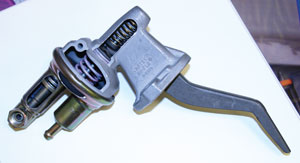Read up on essential products in our annual technical sales seminar section. We review 12 products you need to know better to move products.
Brakes
Fuel Pumps
Gaskets
Batteries
Wipers
Catalytic Converters
Shocks
Engine Management
Lighting
Belts and Hoses
Oxygen Sensors
Antifreeze
The fuel pump is a vital component that keeps the engine running. Most late-model vehicles have a high-pressure electric pump mounted inside the fuel tank to supply the engine with fuel. The pump not only delivers fuel but also develops the pressure necessary to force fuel through the injectors when the engine is running. Most pumps generate from 35 to 80 PSI depending on the application.
 If the pump stops running for any reason, or fails to deliver the required pressure and volume to keep the engine running, the engine may stall, run poorly or refuse to start. It’s one repair that cannot be postponed because the vehicle isn’t going anywhere until the fuel delivery problem has been diagnosed and corrected.
If the pump stops running for any reason, or fails to deliver the required pressure and volume to keep the engine running, the engine may stall, run poorly or refuse to start. It’s one repair that cannot be postponed because the vehicle isn’t going anywhere until the fuel delivery problem has been diagnosed and corrected.
A fuel delivery or pressure problem doesn’t always mean the fuel pump needs to be replaced. The problem may be something else such as a bad fuel pump relay, blown fuse, a loose, shorted or corroded wiring connection in the fuel pump circuit, a plugged fuel filter, a pinched or restricted fuel line, a leaky or defective fuel pressure regulator or no gas in the tank.
Accurate diagnosis is essential to prevent unnecessary fuel pump replacements, returns and warranty claims. To briefly summarize, it’s important to diagnose the cause of a fuel delivery problem before replacing any parts. If a pump fails to run when the ignition key is turned on, it might be a bad pump or it might be an electrical fault. If the pump runs but fails to develop normal pressure (which requires testing with a gauge at the fuel rail on the engine), it might indicate a weak pump, a fuel line restriction or a leaky fuel pressure regulator.
Fuel volume also is important. A weak pump may generate normal pressure at idle, but fail to keep up as engine load and speed increase. A good pump should usually deliver a quart of fuel in 30 seconds.
If a pump needs to be replaced, the next step in the process is to make sure your customer gets the correct replacement pump. You will obviously need the year, make and model of the vehicle, and probably the engine size. You may also need to know the vehicle VIN, the body style, or the type of fuel tank (steel or plastic) on some applications. With pickup trucks that have dual tanks and multiple pumps, you need to know which pump the customer wants to replace. It also helps if the customer can bring in the old pump so you can make a visual comparison and refer to the ID tag or part number.
Other items that should also be replaced include the rubber sealing ring that goes under the pump cover on the fuel tank, the fuel filter and the pump inlet filter sock inside the tank. Contamination is the No. 1 cause of fuel pump failures as well as repeat pump failures.
On older, high-mileage vehicles, rubber fuel lines should be replaced if the hoses have become brittle or cracked. The fuel pump wiring harness also may have to be replaced if it is corroded or burned. A new fuel pump relay is also recommended to prevent problems down the road.
A good source of information on this subject is the Fuel Pump Manufacturer’s Council (FPMC). They have a number of training videos that can be viewed on the Automotive Aftermarket Suppliers Assn. (AASA) website. Go to www.fuelpumpinfo.org. Click on the free training videos link at the bottom of the page, then choose the AASA Jobber tab to watch the counterman videos. Topics include fuel pump selling tips, additional sales, installation advice and return analysis.
A problem that has plagued all fuel pump manufacturers for many years is the high number of unnecessary returns and warranty claims. Misdiagnosis is the most common reason for this, but also technician error. Plastic fuel line connections on pump modules can be easily broken if mishandled. Wiring can also be damaged if not connected correctly.
Many “defective” pumps that are returned run fine when bench-tested. The pump didn’t work in the vehicle because there was likely an electrical problem or a fuel line restriction. Many pumps that fail while still under warranty die because of contamination. That’s why the inside of the fuel tank needs to be inspected and cleaned if found to be dirty. A steel tank that is rusty, or a plastic tank that is deteriorating (which they do after years of use) needs to be replaced.
Pumps that are returned under warranty need to be inspected to see if the pump has been damaged during installation (which voids the warranty). Ditto for pumps that are obviously contaminated. The pump also needs to be correctly identified and labeled before it goes into the box and is returned to the manufacturer.













